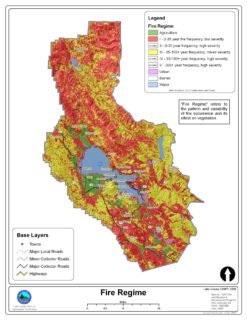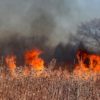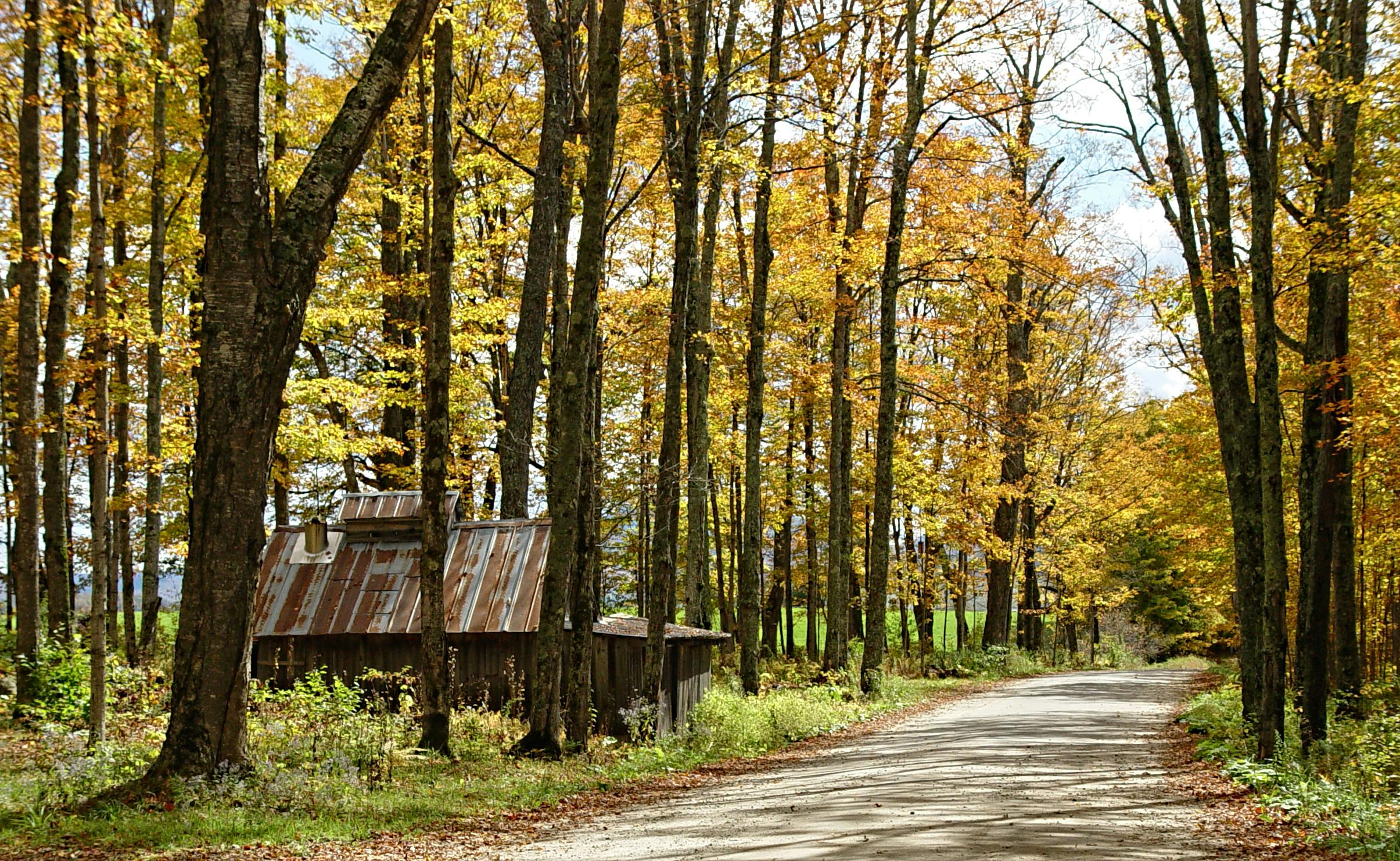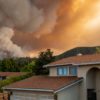With Lake County now holding the title of the largest fire in California’s recorded history, the Ranch Fire of the Mendocino Complex, it leaves one to wonder what exactly it is that’s producing the conditions for these enormous fires to thrive in this area. It has been estimated that in the last 5 years, over 55 percent of the surface area in Lake County has burned in wildfires. It has become an unfortunate understanding of the residents that have chosen to settle in this county that it is not if a big fire will occur, but rather, when will the next one occur. In regards to wildland fire, there are three main elements that are known to have the most impact on fire behavior: weather, topography, and fuels. Unfortunately for Lake County, the area has all three of these influential factors working against the fire regime of the area.
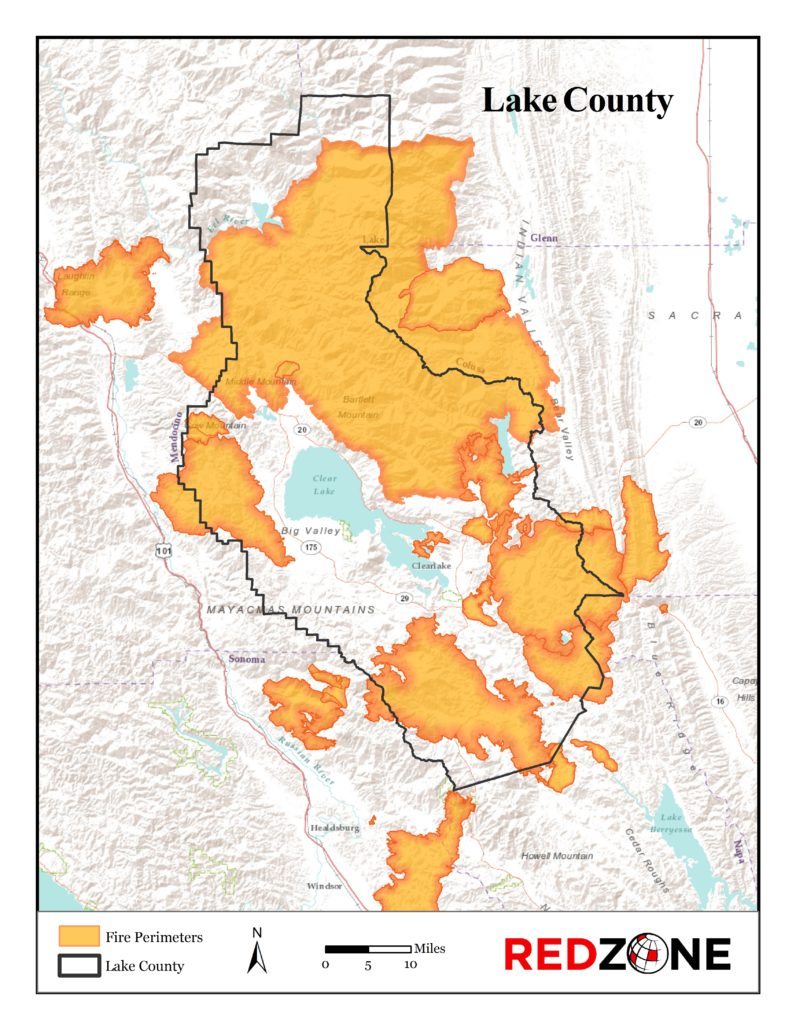
This map displays all of the fires inside a 1 mile buffer of Lake County that reached over 100 acres since 2012.
Topography
Lake County is located in the Coastal Range of northern California, on the west side of the Sacramento Valley. Lake County resides in a mid-altitude area that is high enough above sea level to be above the influence of the marine layer, but not high enough in the mountains to feel impacts of the cooler upper atmospheric air. In the center of the county rests Clear Lake, which is the lowest point in elevation throughout the entire area. Surrounding this geographic feature are seemingly endless mountains, hills, and valleys extending in every direction until they arrive in the northern reaches of the Mendocino National Forest. These areas of tremendous elevation variation are where fires tend to thrive. Fires are able to take advantage of these slopes to preheat the fuels up-slope from the fire, while simultaneously utilizing the convection column of hot gasses being funneled through these drainages to fuel the fire’s spread.
Weather
The local weather patterns of Lake County tend to have a negative impact on fire behavior in the area. During fire season, the predominate winds blow from the northwest, with the occasional shift coming from the northeast, bringing the warm and dry air from the northern portion of the Sacramento Valley into the area. On the extreme side of the spectrum are Foehn Wind events that cause extreme fire behavior when they occur. Foehn or “sundowner” winds bring hot, dry air into the area, with an uncharacteristic down-slope flow that allows fire to spread at unfathomable rates. When these events occur, fires can continue to burn actively through the night which is usually the time when fire behavior begins to moderate.
Fuels
Lake County is relatively diverse in terms of the vegetation species throughout the county’s boundaries. Nearly every major fuel type that exists is contained within the county including grasslands, oak woodlands, brush, mixed conifer forests, and hardwood forests. Due to the wide spectrum of vegetation species here, fires can range from low intensity grass fires, to extremely high intensity forest fires. The map below depicts the vegetation classifications throughout the entire county. Starting in the southern areas of the county, the predominate fuel type is comprised of annual grasses and oak woodlands. As you move up in elevation on both the east and the western side of Clear Lake, the fuel type primarily changes to a chaparral-based fuel bed. Progressing further north into the Mendocino National Forest, the dominant fuel type changes once again to one of a heavy timber, mixed conifer, and hardwood forested area.
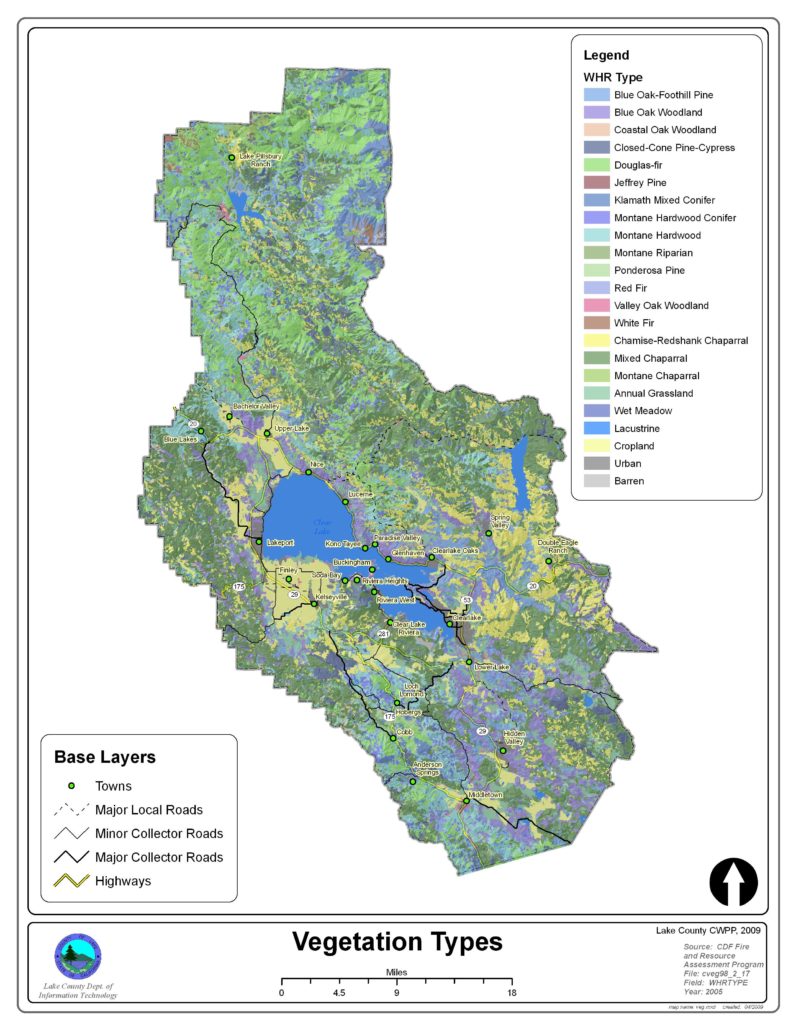
This map depicts the vegetation types throughout Lake County. Visualizing this data clearly shows the predominant vegetation type shifting as you progress north, from the southern border of the county.
The reasons above are all variables in what seems to be a devastating half-decade of fire history for the Lake County region. The complicated wildfire situation in this area has been influenced by the recent years of drought, which has decreased the available moisture in the region, drying out the vegetation and furthering their susceptibility to fire. Lastly, Lake County has had an increase in residency due to increasing interest in the Napa/Sonoma Wine country. With more human influence comes the increased probability of fires igniting.
Insurance risk or Opportunity?
Will this information impact insurance companies when considering existing policies, writing future business, or even adjusting premium rates in this county? Does this amount of fire activity in such a small time frame deter insurance carriers from writing new business in these areas? These recently charred areas should be considered as an opportunity to obtain new clientele due to the diminished risk from wildfire in the upcoming years based off the lack of vegetation. Some factors to take into account would be the return interval rate of fire in each of these fuel types. This knowledge would give an estimation of how long that specific site will have before it is ready to burn if the new vegetation is the same species. For example, Chaparral brush which, is a large portion of Lake Counties fuel, has a highly variable fire return interval ranging from 10 to over 100 years. If properly managed an individual could easily keep fire from returning to the landscape for a long period of time. Another advantage of insuring homeowners in recent burn areas, is the opportunity to educate them with advice on how to manage the vegetation around their home as it begins to regrow. This would in turn, promote defensible space around the structure, and give the client a piece of mind that their insurance company cares for their home, while simultaneously protecting the insurers investment.
Sources
http://www.lakecountyca.gov/Assets/County+Site/Fire+Safe+Council/cwpp/eco.pdf
http://www.lakecountyca.gov/Government/Boards/lcfsc/LCCWPP.htm
http://www.latimes.com/local/lanow/la-me-lake-county-fire-epicenter-20180814-story.html
http://www.californiachaparral.com/fire/firenature.html
https://www.weatheronline.co.uk/reports/wxfacts/The-Foehn-foehn-wind.htm
https://www.nfpa.org/-/media/Files/Training/certification/CWMS/S-190-Intro-to-Wildland-Fire-Behavior.ashx?la=en

